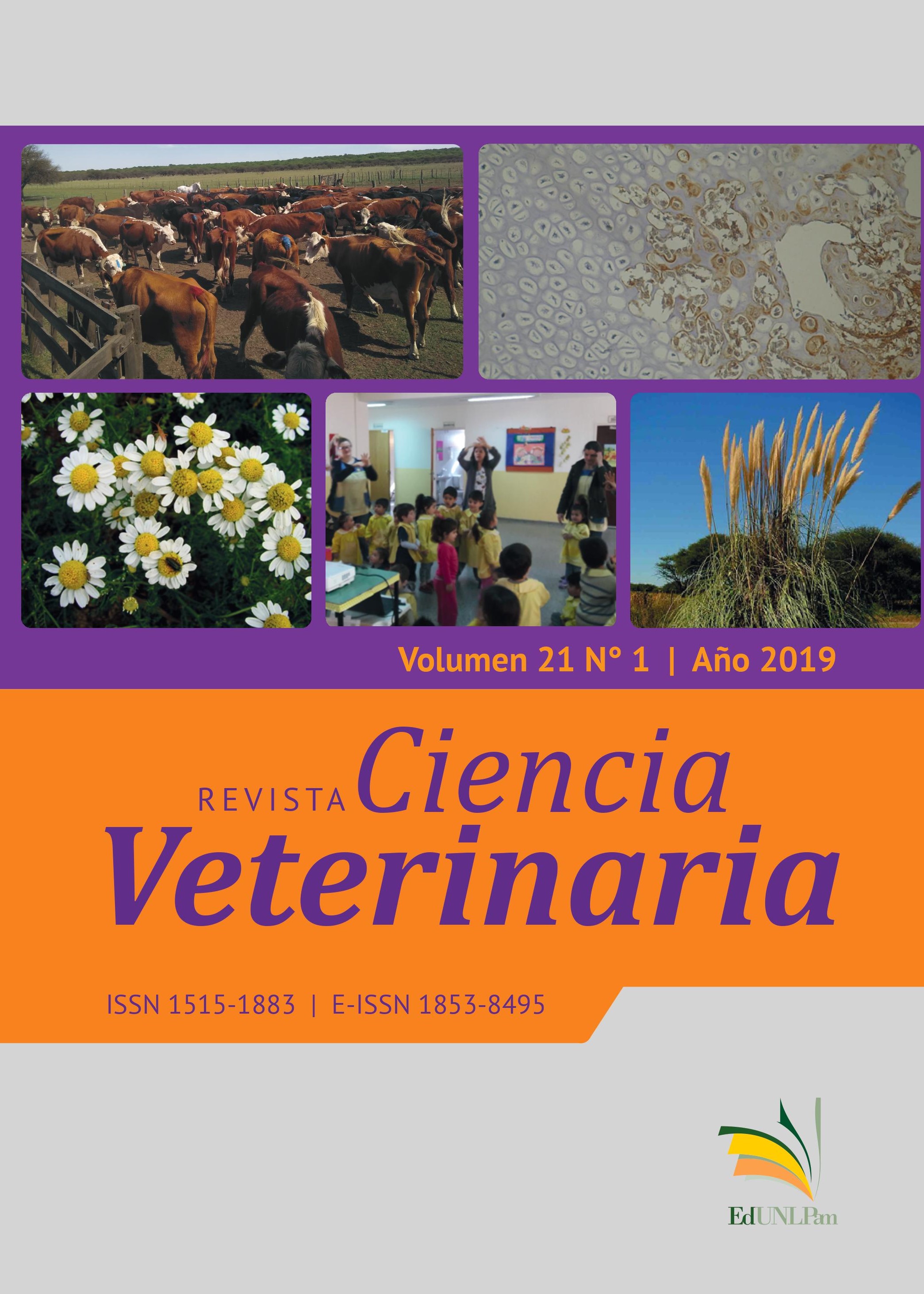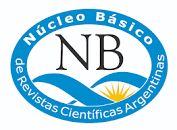Wingless int-3 (Wnt3) Immunodetection in the repair of orthopedic bone defects in rabbits treated with demineralized bone matrix
DOI:
https://doi.org/10.19137/cienvet-201921102Keywords:
Wnt, demineralized bone matrix, rabbit, bone, immunostainingAbstract
Although the expression Wnt and its isoforms are widely known in the embryonic skeletogenesis, little is known about the role they play in the particular Wnt3 isoform in the repair of orthopedic bone defects. Thirty rabbits were used, which were given a bone defect in
one of the radiuses. The defect was refilled with demineralized bone matrix (DBM). The rabbits were sacrificed at 7, 15, 21, 30, 60 and 150 days post-treatment to immuno-detect the Wnt3 in the repair sites. The immuno-determination was done by optic density (OD) and integrated optic density (IOD). Both, the OD and the IOD were analyzed
using ANOVA and Fisher LSD test. The Wnt3 protein was immuno-detected in mesenchymal cells, in the sites where the chondrogenesis was produced and in osteoprogenitor, preosteoblasts and osteoblasts cells. The OD had significant variations (p<0,05) at 7, 15, 60 and 150 days post-treatment. The same statistical analysis for IOD showed significant
statistical differences (p<0,05) at day 30 with respect to 60 and 150 days post-treatment. The evidence showed the histological sites as well as the chronological immune expression of Wt3 in the repair of orthopaedic bone defects treated with demineralized bone matrix.
Downloads
References
Urist, M.R. Bone formation by autoinduction. Science. 1965; 150: 893-899.
Ganesh, T.N. Comparative studies on bone grafting for radial fracture using autogeneic cancellous bone, allogeneic demineralized bone matrix and xenogeneic demineralized bone matrix for better osteogenesis in canines. Indian Journal of Veterinary Surgery. 1992; 14:1-48.
Kumar, R.V.S.; Ramakrishna, O. Femoral fracture repair by demineralized bone matrix combinations in canines. Indian Journal of Animal Sciences. 2001; 71:749-751.
Hoffer, M.J.; Griffon, D.J.; Schaeffer, D.J.; Johnson, A.L.; Thomas, MW. Clinical applications of demineralized bone matrix: a retrospective and case-matched study of seventy- five dogs. Veterinary Surgery. 2008; 37:639-647.
da Silva, S.W.G.; de Castro, R.P.; deViana, G.A.; dos Santos, F.R.; de Moraes, R.S.; do Oriente, V.N. Estenose de pelve em felino tratado com anel de matriz óssea desmineralizada (MOD) - relato de caso. Clínica Veterinária. 2012; 17:46-50.
Colnot, C.; Romero, D.M.; Huang, S.; Helms, J. Mechanism of action of demineralized bone matrix in the repair of cortical bone defects. Clinical Orthopaedic Related Research. 2005; 435:69-78.
Eppley, B.L.; Pietrzak, W.S.; Blanton, M.W. Allograft and alloplastic bone substitutes: a review of science and technology for the craniomaxillofacial surgeon. Journal of Craniofacial Surgery. 2005; 16:981-989.
Gavin, B.J.; McMahon, J.A.; McMahon, A.P. Expression of multiple novel Wnt-1/
int-1-related genes during fetal and adult mouse development. Genes Development. 1990; 4:2319–2332.
Cadigan, K.M.; Nusse, R. Wnt signaling: a common theme in animal development.
Genes Development. 1997; 11:3286-3305.
Miller, J.R. The Wnts. Genome biology. 2002; 3:3001-3015.
Luo, Q.; Kang, Q.; Si, W; Jiang, W.; Park, J.K.; Peng, Y.; Li, X.; Luu, H.H.; Luo, J.; Montag, A.G.; Haydon, R.C.; He, T.C. Connective tissue growth factor (CTGF) is regulated by Wnt and bone morphogenetic proteins signaling in osteoblast differentiation of mesenchymal stem cells. Journal Biology Chemistry. 2004; 279:55958-55968.
Rodda, S.J.; McMahon, A.P. Distinct roles for Hedgehog and canonical Wnt signaling in specification, differentiation and maintenance of osteoblast progenitors. Development. 2006; 133:3231–3244.
Hartmann, C. A Wnt canon orchestrating osteoblastogenesis. Trends in Cell Biology. 2006; 16:151–158.
He, X.; Semenov, M.; Tamai, K.; Zheg, X. LDL receptor related proteins 5 and 6 in Wnt/b-catenin signaling: arrows point the way. Development. 2004; 131:1663–1677.
Kelly, O.G.; Pinson, K.I.; Skarnes, W.C. The Wnt co-receptors Lrp5 and Lrp6 are essential for gastrulation in mice. Development. 2004; 131:2803–2815.
Huang, H.; He, X. Wnt/beta-catenin signaling: new (and old) players and new insights. Current Opinion in Cell Biology. 2008; 20:119-125.
Sugimura, R.; Li, L. Noncanonical Wnt signaling in vertebrate development, stem cells, and diseases. Birth Defects Research. Part C. Embryo Today. 2010; 90:243-256.
Audisio, S.A.; Vaquero, P.G.; Torres, P.A.; Verna, E.C.; Ocampo, L.N.: Ratusnu, V.; Cristofolini, A.L.; Merkis, C.I. Obtención, caracterización y almacenamiento de matriz ósea desmineralizada. Revista de Medicina Veterinaria. 2014; 95:27-34.
Schmitz, J.P.; Hollinger, J.O. The critical size defect as an experimental model for craniomandibulofacial nonunions. Clinical Orthopaedic Related Research. 1986; 205:299-308.
Hollinger, J.O.; Kleinschmidt, J.C. The critical size defect as an experimental model to test bone repair methods. Journal of Craniofacial Surgery.1990; 1:60-68.
Vasconcellos, A.; Cisternas, C.; Paredes, M. Estudio inmunohistoquímico comparativo del receptor de estrógeno en tejido endometrial de ovejas razas Texel y Araucana. Int. J. Morphol.2014; 32:1120-1124.
Di Rienzo, J.A.; Casanoves, F.; Balzarini, M.G.; Gonzalez, L.; Tablada, M.; Robledo, C.W. InfoStat versión 2010 Grupo InfoStat, FCA, Universidad Nacional de Córdoba, Argentina.
Zhong, N.; Gersch, R.P.; Hadjiargyrou, M. Wnt signaling activation during bone
regeneration and the role of dishevelled. in chondrocyte proliferation and
differentiation. Bone.2006; 39:5–16.
Chen, Y.; Whetstone, H.C.; Youn, A.; Nadesan, P.; Chow, E.C.Y.; Lin, A.C.; Alman, B.A. β-catenin signaling pathway is crucial for bone morphogenetic protein 2 to induce new bone formation. Journal Biological Chemistry. 2007; 282:526-533.
Monroe, D.G.; McGee-Lawrence, M.E.; Oursler, M.J.; Westendorf, J.J. Update on Wnt signaling in bone cell biology and bone disease. Gene. 2011; 492:1-18.
Tu, X.; Joeng, K.S.; Nakayama, K.I.; Nakayama, K.; Rajagopal, J.; Carroll, T.J.; McMahon, A.P.; Long, F. Noncanonical Wnt signaling through G protein-linked PKCdelta activation promotes bone formation. Developmental Cell.2007; 12:113-127.
Fischer, L.; Boland, G.; Tuan, R.S. Wnt-3A Enhances bone morphogenetic protein- 2-mediated chondrogenesis of murine C3H10T1/2 mesenchymal cells. The Journal of Biological Chemistry. 2002; 277:30870–30878.
Rawadi, G.; Vayssière, B.; Dunn, F.; Baron, R.; Roman-Roman, S. BMP-2 controls alkaline phosphatase expression and osteoblast mineralization by a Wnt autocrine loop. Journal of Bone and Mineral Research. 2003; 18:1842–1853.
Fujita, T.; Azuma, Y.; Fukuyama, R.; Hattori, Y.; Yoshida, C.; Koida, M.; Ogita, K.; Komori, T. Runx2 induces osteoblast and chondrocyte differentiation and enhances their migration by coupling with PI3K-Akt signaling. Journal of Cell Biolgy. 2004; 166:85–95.
Phimphilai, M.; Zhao, Z.; Boules, H.; Roca, H.; Franceschi, R.T. BMP signaling is required for RUNX2-dependent induction of the osteoblast phenotype. J Bone and Mineral Research. 2006; 21:637–646.
Nelson, W.J. Regulation of cell-cell adhesion by the cadherin-catenin complex. Biochemistral Society Transactions. 2008; 36:149-155.
Dong, Y.F.; Soung do, Y.; Schwarz, E.M.; O’Keefe, R.J.; Drissi, H. Wnt induction of chondrocyte hypertrophy through the Runx2 transcription factor. Journal of Cellular Physiology. 2006; 208:77-86.
Marsell, R.; Einhorn, T.A. The biology of fracture healing. Injury. 2011; 42:551-555.
Bigham-Sadegh, A.; Oryan, A. Basic concepts regarding fracture healing and the current options and future directions in managing bone fractures. Internal Wound Journal. 2015; 12:238–247.
Gibson, G.J.; Kohler,W.J.; Schaffler, M.B. Chondrocyte apoptosis in endochondral ossification of chick sterna. Developmental Dynamics. 1995; 203.468-476..
Scammell, B.E.; Roach, H.I. A new role for the chondrocyte in fracture repair: Endochondral ossification includes direct bone formation by former chondrocytes. Journal of Bone and Mineral Research. 1996; 11:737–745
Hill, T.P.; Spater, D.; Taketo, M.M.; Birchmeier, W.; Hartmann, C. Canonical Wnt/β-catenin signaling prevents osteoblasts from differentiating into chondrocytes. Dev. Cell. 2005; 8:727–738.
Zhou, X.; von der Mark, K.; Henry, S.; Norton, W.; Adams, H.; de Crombrugghe, B. 2014. Chondrocytes transdifferentiate into osteoblasts in endochondral bone during development, postnatal growth and fracture healing in mice. PLoS Genet. 10, e1004820.
Moon, R.T.; Brown, J.D.; Torres, M. WNTs modulate cell fate and behavior during vertebrate development. Trends in Genetics. 1997; 13:157–162.
Hartmann C.; Tabin C.J. Dual roles of Wnt signaling during chondrogenesis in the chicken limb. Development. 2000; 127:3141–3159.
Church, V.; Nohno, T.; Linker, C.; Marcelle, C.; Francis-West, P. Wnt regulation of chondrocyte differentiation. Journal of Cell Science. 2002; 115:4809–4818.
Downloads
Published
How to Cite
Issue
Section
License
Al momento de enviar sus contribuciones, los colaboradores deberán declarar , de manera fehaciente, que poseen el permiso del archivo o repositorio donde se obtuvieron los documentos que se anexan al trabajo, cualquiera sea su formato (manuscritos inéditos, imágenes, archivos audiovisuales, etc.), permiso que los autoriza a publicarlos y reproducirlos, liberando a la revista y sus editores de toda responsabilidad o reclamo de terceros , los autores deben adherir a la licencia Creative Commons denominada “Atribución - No Comercial CC BY-NC-SA”, mediante la cual el autor permite copiar, reproducir, distribuir, comunicar públicamente la obra y generar obras derivadas, siempre y cuando se cite y reconozca al autor original. No se permite, sin embargo, utilizar la obra con fines comerciales.









.jpg)

4.png)


7.png)



